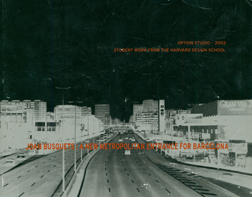Joan Busquets: A New Metropolitan Entrance for Barcelona
 As in the past, entrances to most cities come by way of roads, and usually along broad arterials that move travelers inexorably in towards city centers from the outlying hinterlands. Unlike in the past, however, the entrance itself is no longer confined to a single moment of crossing some threshold, breaching a wall, or going through a gate. Instead, the roadway itself and its abutting properties form the entrance or, rather, entry sequence to contemporary cities, usually for several kilometers.
As in the past, entrances to most cities come by way of roads, and usually along broad arterials that move travelers inexorably in towards city centers from the outlying hinterlands. Unlike in the past, however, the entrance itself is no longer confined to a single moment of crossing some threshold, breaching a wall, or going through a gate. Instead, the roadway itself and its abutting properties form the entrance or, rather, entry sequence to contemporary cities, usually for several kilometers.
Furthermore, the importance of this sequence of arrival has been made even more significant by the inevitable placement of larger transportation hubs—like airports—on the periphery of most cities, where there is ample space and room for expansion. Unfortunately, through these entry roadway environments rarely receive explicit design attention, as did the often splendid city gates of the past, and often remain in a poorly-considered and circumstantial state. (Its as if visitors are expected to close their eyes after leaving the shiny airport terminals only to open them once they have truly arrived in the city proper, with a sort of spatio-temporal parenthesis in between.) In fact, modern-day arrival in Barcelona, with movement along the Grand Via from across the Llobregat River into the city center, is no exception to these contemporary conditions. Therefore, the urban design and planning problem set by Professor Joan Busquets is both an important general class of problem, applicable to many cities, as well as being a problem of specific significance to Barcelona—the city in which it was set.
Within this general class of problem, and its application to Barcelona, several other important issues emerge immediately. When we say ‘entry sequence,’ for instance, how should such a sequence be formulated spatially? Should it be a carefully orchestrated succession of buildings and elements of infrastructure as signs, symbols and markers along the way? Should it simply try to make a horizontal cross-section through the city more visible and more intelligible? Or, should it strive to have its own internal coherence, a little like an elongated gateway? Then too, there are technical issues associated with roadway alignments, accommodation of traffic of different kinds, and resolving the need for movement in many different directions. For example, along the Gran Via, as elsewhere in similar circumstances, there is a need to provide for volumes of high-speed traffic, moving from the inner-city barriers to perpendicular movement and to the urban development that usually follows these flows of movement. However, they may also be regarded as seams or as centers of activity, rather than as edges, depending upon how local roadways and surrounding buildings are constructed and how movement patterns are orchestrated. Also, in another set of issues, opportunities are presented for re-development and re-vitalization of the city-building process, by focusing urban design attention on roads like the Gran Via. Adjacent perfunctory building layouts, for instance, have the opportunity to become better resolved. Well-made sections of town can be extended and special institutional, or other locations, can receive the prominence they deserve.
In the following pages of this publication you will see various responses to thes issues among the proposals and, in effect, to the general class of problem of how to approach the new, modern-day making of an entrance to a large metropolitan area like Barcelona. Of interest is the sheer variety and scope of compelling ways this kind of general problem seems able to be tackled frome ssentially the same baseline conditions. This may be a reflection of the times, where there is no hegemonic design paradigm in place that would otherwise unify individual design proposals. It also may be due to the vagueness of many surrounding site circumstances, allowing for multiple interpretations, although we would also like to think that it has to do with the creative imaginations of the individual designers and planners involved. In any event, in what follows there is some questioning of conditions already in place and taken for granted, considerable useful design speculation, and much food for though.
— Peter G. Rowe
from his Foreword
Student Work, Harvard University Graduate School of Design, 2003